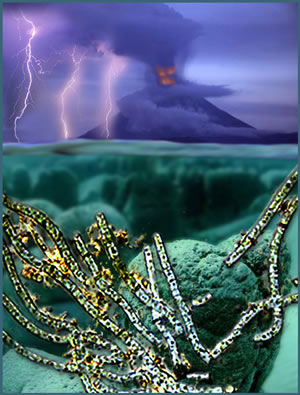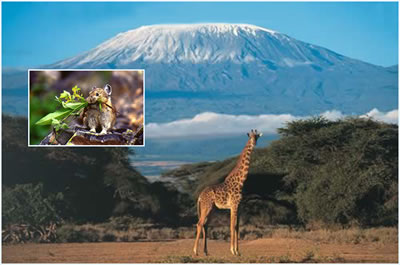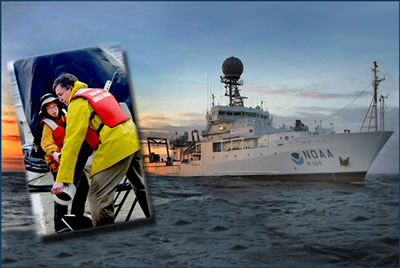Water: Science Looks at the Source of Life
By Paul Preuss
But if (and oh! what a big if!) we could conceive in some warm little pond, with all sorts of ammonia and phosphoric salts, light, heat, electricity, etc., present, that a protein compound was chemically formed ready to undergo still more complex changes ...
— Charles Darwin
Four billion years ago it would have been hard to find anything resembling Darwin’s “warm little pond” anywhere on Earth. The oceans were acid, the atmosphere was carbon dioxide, and anything touched by the sun was fried by ultraviolet light. However they got started, the first single-celled organisms lived on methane and bicarbonates, and to survive they secreted tough films, lived underwater, and stuck together.

Billions of years ago photosynthesizing bacteria formed clumps called stromatolites in shallow seas. The photosynthetic water-splitting mechanism they used is the same today.
Then some of these bugs acquired a neat trick: photosynthesis. Nature had stumbled upon a way to use sunlight to split water into oxygen molecules and hydrogen ions – freeing electrons for chemical reactions that converted carbon dioxide and other nutrients into compounds useful for growing things.
The key to photosynthesis was the water-splitting machinery that plants, algae, and cyanobacteria still use today, a cluster of manganese and calcium atoms which Vittal Yachandra and his colleagues in Berkeley Lab’s Physical Biosciences Division believe were most probably borrowed from the waters near undersea vents and other sites of active ocean chemistry.
Photosynthesis provided the sine qua non of modern life (with a few extremophile exceptions), namely free oxygen, including most of the oxygen in the atmosphere today. Teeming phytoplankton near the ocean’s surface still accounts for half of all the oxygen produced by plants.
The ocean plays another critical and closely related role in sustaining life on Earth: as it puts oxygen into the atmosphere it takes carbon dioxide out — by some estimates, the oceans absorb two billion metric tons of carbon a year, a third of the total currently emitted by human activity. Sequestering more carbon in the ocean might be one way to keep it out of the atmosphere and slow global warming. Maybe.
How much longer can the ocean continue to soak up what humans dump into the air? That depends on many factors, most not well understood. As important as liquid water are water’s gaseous and solid phases – clouds, snow, and ice – which reflect sunlight and help cool the air and the surface of Earth.
Ice, snow, rain, and groundwater
Alas, temperature is part of a vicious feedback loop. Once snow and ice melt, land and sea absorb more heat; temperatures can rise higher, causing snow and ice to melt faster. The ice that covers Greenland, the Arctic sea ice, and the ice sheets of Antarctica are melting precipitously. The snows of Kilimanjaro and the glaciers of the Alps, the Andes, and Glacier National Park are going fast. Just how fast is a matter of discussion, but recent reports suggest that Arctic sea ice is melting so fast most of it could be gone in 30 years.
The oceans are rising. Estimates differ, but none are encouraging. Should the West Antarctic Ice Sheet break up suddenly, sea level will rise not by centimeters but by meters per century. Port facilities worldwide will be submerged; atolls and island chains will vanish; parts of Bangladesh, Brazil, Burma, America’s Gulf States, and other low-lying areas will flood; Venice, New Orleans, and many other cities will sink.

As temperature rises, ice melts, as in the vanishing “Snows of Kilimanjaro,” causing temperature to rise faster. Plants and animals move toward the poles and to higher altitudes. Some species adapted to cool mountaintops have nowhere to move and will become extinct.
Clouds are more subtle than ice. They bring rain and snow that sustain land plants and fill reservoirs, and they moderate the sunlight that reaches Earth – but when clouds become polluted with other forms of aerosols like soot or sulfur dioxide, they can turn into heat absorbers. Surabi Menon of the Earth Sciences Division has found that droughts in North China and floods in South China have been increasing for decades because soot, whether from wood fires, auto exhaust, or coal-burning power plants, has changed where the precipitation falls.
In a surprising way, sea level fluctuations and the residue of coal-burning power plants have intersected to affect the quality of drinking water in Bangladesh, where lower sea levels in the past contributed to one of the country’s most urgent problems today, the mass poisoning of tens of millions of people by dangerous concentrations of arsenic in shallow wells. Just why these wells are contaminated is controversial, but the source of the arsenic is known: it comes from sediments laid down since the last Ice Age, when sea levels in the region were 100 meters lower.
Ashok Gadgil of Berkeley Lab’s Environmental Energy Technologies Division has devoted much of his career to providing disadvantaged people with economical means for purifying water. To address arsenic poisoning of well water in Bangladesh, for example, he and his colleagues concocted cheap filters made from the fly ash residue in coal-burning power plants. Tea-bag-size filters made from coal ash remove arsenic from well water at a cost of about 30 cents per person per day.
Gadgil had earlier created an inexpensive filter to remove biological contaminants from drinking water, a device called UV Waterworks that kills waterborne pathogens with ultraviolet light – it can be powered by a car battery, a solar panel, or even a bicycle generator, and purifies water at the rate of four gallons a minute, costing only about two cents for a ton of water.
How humans use fresh water, for drinking, agriculture, industry, electricity production, transportation, recreation, waste disposal, and in numerous other ways, mightily affects how much clean water will be available in the future. But more fundamental than patterns of human use is climate change.
Climate means water
“When I say climate, I mean water,” says climate modeler Inez Fung of Berkeley Lab’s Earth Sciences Division, a professor of atmospheric science at UC Berkeley and the founder of the Berkeley Atmospheric Sciences Center and the Berkeley Institute for the Environment. “It’s the basis of the whole earth system.”
Water is the key to any attempt to understand what Earth’s changing climate has in store for us. Rising temperatures interfere with the mixing of surface and deeper layers of the ocean that carries carbon deep and keeps it there. And as temperature increases, plants on land conserve water by breathing less.
Fung says, “Plants are happy growing at a certain rate, and though they can accelerate to a certain extent with more CO2, the rate is limited” – notably by lack of water. Fung’s modeling of the “breathing biosphere,” phytoplankton and land plants both, indicates that “the faster the emissions from fossil fuels, the less effective the land and ocean as carbon sinks.”
Oceanographer Jim Bishop of the Lab’s Earth Sciences Division has focused much of his career on understanding the chemistry of the ocean, especially in its effects on the “biological pump” – the pathways by which life, beginning with the phytoplankton that absorbs carbon dioxide from the air, eventually transports some of the carbon to the bottom of the ocean.

Jim Bishop and colleague Phoebe Lam launch a Carbon Explorer float from the Research Vessel Ronald H. Brown to measure particulate carbon.
One dramatic example of ocean chemistry’s effect on plant life is the role of iron. Iron isn’t a primary nutrient like phosphorus, nitrogen, and silicon, but small quantities of iron are essential to promote growth. The Iron Hypothesis proposed by the late John Martin of Moss Landing Marine Laboratories holds that in areas known as high-nutrient, low chlorophyll (HNLC) regions, the reason “chlorophyll” (plant growth) is low is the shortage of iron. When these regions get enough iron, the plankton blooms. So much has been proved.
Scientists long suspected that the main source of iron in the oceans was dust storms blowing from desert regions like the Sahara. In 2001 Jim Bishop was the first to actually observe this linkage, when two of his robotic Carbon Explorer floats recorded the rapid growth of phytoplankton in the upper layers of the North Pacific Ocean, after a passing storm had deposited iron-rich dust from the Gobi Desert.
Bishop’s deep-diving Carbon Explorers were based on the SOLO floats designed at the Scripps Institution of Oceanography to measure temperature and salinity at various depths. Bishop engineered them to measure particulate carbon in the upper thousand meters of the ocean and report their data by satellite – 24-hour-a-day data collection for months or years at a time by robotic instruments whose total cost per Carbon Explorer was about the same as operating a research vessel for just one day.
It was records from traditional ship-borne instruments, however – lowered over the side and brought back aboard for chemical analysis – that first indicated that iron from continental margins is more important than wind-blown dust in fertilizing plankton blooms. Bishop and his colleagues showed that the key source of iron in the Western North Pacific is the volcanic Kamchatka Peninsula and the Kuril Islands. Farther east in the North Pacific, iron from the Aleutian islands and the mainland of Alaska travels far out to sea and is brought to the surface by winter storms, creating plankton blooms during the darkest days of the year.
More recently, more than a year’s worth of data from Carbon Explorer floats in the Southern Ocean have cast doubt on the more provocative version of John Martin’s Iron Hypothesis, which he famously stated as “Give me half a tanker of iron and I’ll give you an Ice Age.” Do plankton blooms increase the amount of carbon stored in the ocean? Probably not.
“What counts is the carbon that reaches the deep sea, and a lot of the carbon tied up in plankton blooms appears not to sink very fast or very far,” says Bishop. At least this is true in the Southern Ocean, for reasons having to do with the seasonal feeding behavior of planktonic animal life. Says Bishop, “Iron is not the only factor that determines phytoplankton growth in HNLC regions. Light, mixing, and hungry zooplankton are fundamentally as important as iron.”
The bottom line, says Bishop, is that "before we can decide whether schemes for storing excess atmospheric carbon in the ocean are safe – or would even work at all – we need to know a lot more about the ocean carbon cycle."
Life came from the oceans, and the oceans have sustained life as we know it for over two billion years. Whether they continue to nurture us, and how long, depends on how responsibly humans can respond to the challenges of a threatened marine environment and an inescapably warming global climate.
Additional Information
-
For more on how the water-splitting mechanism of photosynthesis may have arisen, visit http://www.lbl.gov/Science-Articles/Archive/sb/July-2004/2_spinach.html
-
For the role of clouds and aerosols in climate, visit http://newscenter.lbl.gov/wp-content/uploads/2008/07/menon-presentation-summerlecture_nom.pdf
-
For Ashok Gadgil’s work in purifying drinking water, go to http://www.lbl.gov/Science-Articles/Archive/EETD-Gadgil-water-filter.html
-
For more on the crucial part played by oceans and fresh water in climate change, see http://www.lbl.gov/Science-Articles/Archive/sabl/2007/Jul/climateChange.html
-
For the danger of abrupt climate change for rising sea levels, visit http://newscenter.lbl.gov/feature-stories/2008/09/17/impacts-on-the-threshold-of-abrupt-climate-changes/
-
Inez Fung’s climate modeling is discussed at http://www.nersc.gov/news/annual_reports/annrep05/research-news/01-heat.html
-
Jim Bishop’s ocean carbon studies are described at http://www.lbl.gov/Science-Articles/Archive/sb-Apr-04-ESD-ocean-carbon.html
-
The source of iron in the North Pacific is described at http://www.lbl.gov/Science-Articles/Archive/sabl/2006/Mar/02-winter-iron.html
and at http://www.lbl.gov/Science-Articles/Archive/ESD-NP-iron.html -
For more on how plankton blooms do not send carbon to the deep ocean, visit http://newscenter.lbl.gov/press-releases/2009/05/06/ocean-carbon-iron/


